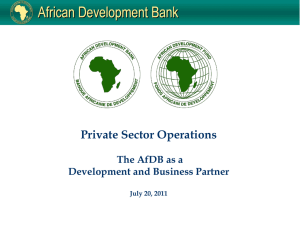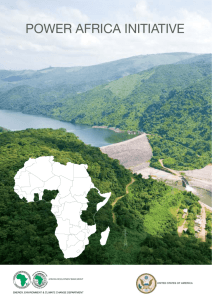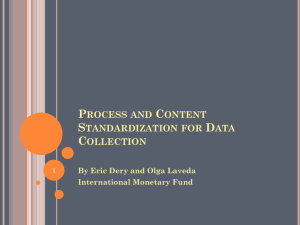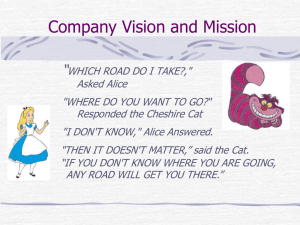CGD Brief A New and Improved African Development Bank? An update on recommendations
advertisement
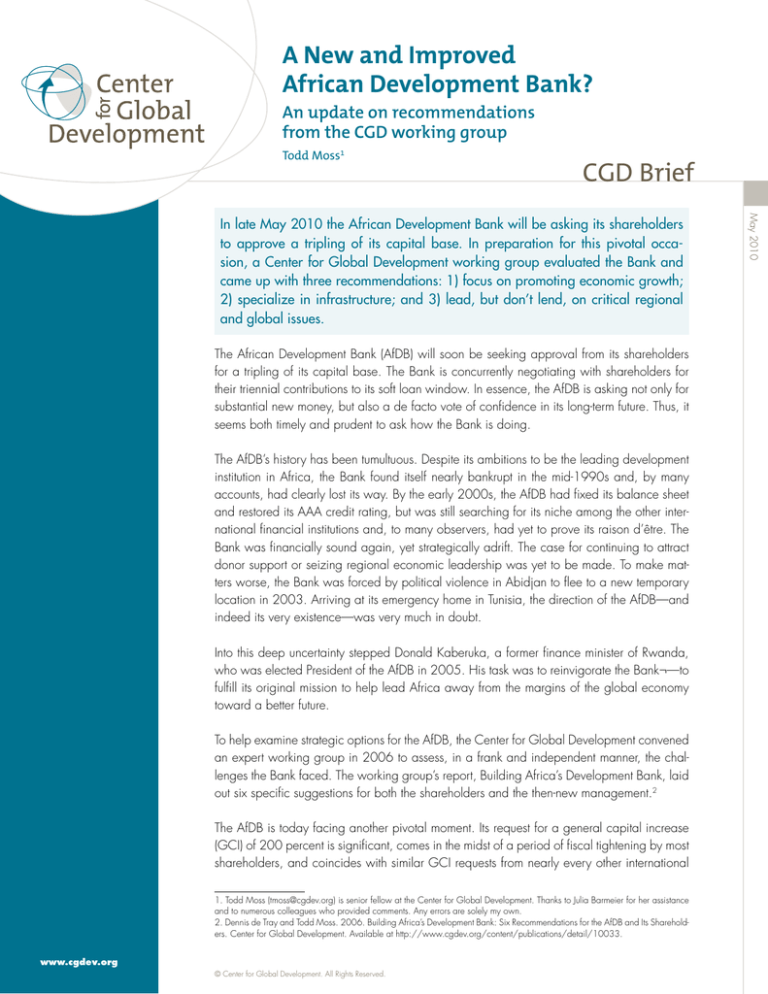
A New and Improved African Development Bank? An update on recommendations from the CGD working group Todd Moss1 CGD Brief The African Development Bank (AfDB) will soon be seeking approval from its shareholders for a tripling of its capital base. The Bank is concurrently negotiating with shareholders for their triennial contributions to its soft loan window. In essence, the AfDB is asking not only for substantial new money, but also a de facto vote of confidence in its long-term future. Thus, it seems both timely and prudent to ask how the Bank is doing. The AfDB’s history has been tumultuous. Despite its ambitions to be the leading development institution in Africa, the Bank found itself nearly bankrupt in the mid-1990s and, by many accounts, had clearly lost its way. By the early 2000s, the AfDB had fixed its balance sheet and restored its AAA credit rating, but was still searching for its niche among the other international financial institutions and, to many observers, had yet to prove its raison d’être. The Bank was financially sound again, yet strategically adrift. The case for continuing to attract donor support or seizing regional economic leadership was yet to be made. To make matters worse, the Bank was forced by political violence in Abidjan to flee to a new temporary location in 2003. Arriving at its emergency home in Tunisia, the direction of the AfDB—and indeed its very existence—was very much in doubt. Into this deep uncertainty stepped Donald Kaberuka, a former finance minister of Rwanda, who was elected President of the AfDB in 2005. His task was to reinvigorate the Bank¬—to fulfill its original mission to help lead Africa away from the margins of the global economy toward a better future. To help examine strategic options for the AfDB, the Center for Global Development convened an expert working group in 2006 to assess, in a frank and independent manner, the challenges the Bank faced. The working group’s report, Building Africa’s Development Bank, laid out six specific suggestions for both the shareholders and the then-new management.2 The AfDB is today facing another pivotal moment. Its request for a general capital increase (GCI) of 200 percent is significant, comes in the midst of a period of fiscal tightening by most shareholders, and coincides with similar GCI requests from nearly every other international 1. Todd Moss (tmoss@cgdev.org) is senior fellow at the Center for Global Development. Thanks to Julia Barmeier for her assistance and to numerous colleagues who provided comments. Any errors are solely my own. 2. Dennis de Tray and Todd Moss. 2006. Building Africa’s Development Bank: Six Recommendations for the AfDB and Its Shareholders. Center for Global Development. Available at http://www.cgdev.org/content/publications/detail/10033. www.cgdev.org © Center for Global Development. All Rights Reserved. May 2010 In late May 2010 the African Development Bank will be asking its shareholders to approve a tripling of its capital base. In preparation for this pivotal occasion, a Center for Global Development working group evaluated the Bank and came up with three recommendations: 1) focus on promoting economic growth; 2) specialize in infrastructure; and 3) lead, but don’t lend, on critical regional and global issues. As part of GCI and ADF discussions, shareholders are engaged in trying to measure the Bank’s efficiency and effectiveness. It also seems an opportune time to revisit each of the six recommendations of the Center’s AfDB working group and ask: How is the Bank doing? It is worth putting the full debate in perspective. Even the consideration of a GCI today is a major sign of success. Just four short years ago, the question was whether the Bank should even exist. Was recovery just wishful thinking? Was it better to just fold the portfolio into the World Bank? Such questions make no sense today. Instead, policymakers are seriously debatig whether the Bank should be two times or three times larger. This alone shows that the Bank is once again (or perhaps, finally) a major player. Recommendations for bank management Our report made three specific recommendations for President Kaberuka and his management team. Below is an update and, for shorthand, grades for progress on each: 1. Define your future: Promoting economic growth should be the Bank’s primary objective. Grade: B+ With donor agencies increasingly targeting the social sectors and public service delivery, the working group recommended a strategic focus on generating higher rates of economic growth in client countries, which, operationally, would mean (a) increasing support for the private sector, (b) working deliberately to connect Africa’s fragmented markets, and (c) promoting better economic governance. This agenda became even more urgent following the global economic crisis, which pushed the region’s overall growth rate down from 5 percent in 2008 to just 1.7 percent in 2009. The AfDB responded aggressively to changing global conditions, launching large emergency liquidity and trade finance facilities (contributing to the need for the GCI) and frontloading disbursements, including accelerated lending to low-income countries. These actions partly mitigated the effects of the crisis and helped prevent the region from falling into recession. REPORT CARD Promoting economic growth: B+ Specializing in infrastructure: ALeading on critical issues: A Reducing shareholder demands: C (2007); Incomplete (2010) Transforming the Board into a nonresident, nonexecutive body: F Settling the location issue: Incomplete Perhaps more important for the long term, the AfDB has been shifting its portfolio to align with growth objectives. Lending through the private sector window has risen steadily, from less than US$300 million per year to more than US$1.5 billion in 2009 (Figure 1). Recent private sector projects have included banking in Liberia and the Democratic Republic of Congo, power projects in South Africa and Egypt, and loans to regional private equity funds. Many of the new requests for capital infusion are to maintain this high level of private sector operations. New approvals for multicountry or regional projects are showing similar dramatic increases, at least in terms of pushing new loans out the door (Figure 1). The lion’s share of these projects is in transportation and power, for example, a new segment of the Bamenda-Enugu Corridor of the Nigeria–Cameroon Highway and a Nile Equatorial Lakes regional power grid. Figure 1 Approvals by Sector 1,400 08–09 1,200 US$ (millions) May 2010 financial institution. At the same time, the Bank’s soft loan window, the African Development Fund (ADF), is also in the midst of negotiations for its regular triennial contributions to enable concessional lending to its low-income clients. It is a huge request at a difficult time. 08–09 1,000 800 06–07 600 400 200 0 Source: AfDB. 06–07 04–05 Private Sector 04–05 Multicountry/Regional 2. Specialize in one sector that matters to growth: Infrastructure. Figure 2 6 Approvals by Sector US$ (billions) 5 4 3 2 1 0 2004 The AfDB has made major progress in becoming largely an “infrastructure bank.” Although the 100 percent infrastructure goal was more of a device than a realistic target, the Bank has substantially increased amounts of new lending directed to that sector, with total infrastructure approvals reaching more than US$5 billion in 2009, greater than all new Bank lending just two years earlier (Figure 2). The proportion of lending for infrastructure has also risen. 3. Lead, but don’t lend, on critical regional and global issues. Grade: A The working group felt strongly that the AfDB was much larger and more important than its loan portfolio, and in a distinctive position to push for reforms that might be more politically difficult for other institutions. We urged the Bank to play a leading role as a voice for the continent in global fora, to be aggressive on international issues of relevance to Africa, and to resist the inevitable urges to dilute the portfolio. In short, Kaberuka should not be shy about using his unique soapbox. 3. Vijaya Ramachandran, Alan Gelb, and Manju Shah. 2009. Africa’s Private Sector: What’s Wrong with the Business Environment and What to Do About It. Center for Global Development. 4. Vivien Foster. 2008. Overhauling the Engine of Growth: Infrastructure in Africa. Africa Infrastructure Country Diagnostic. World Bank. 2005 2006 Social Sector Grade: A- Infrastructure is a major impediment to economic growth in the region.3 Decades of underinvestment by governments in the region, combined with growing donor aversion to financing large infrastructure, have left a significant gap.4 There is a unique opportunity for the AfDB to step into the fold. Not only is the demand for new projects tremendous, but infrastructure appears is a sector in which the AfDB has a reasonably good record and reputation. The working group even recommended moving toward a portfolio of new loans exclusively in infrastructure. May 2010 The more difficult area is good governance, where other instruments are less obvious. Arguably, the AfDB is better placed than its Washington-based peers to push its clients toward best practice, but its leverage and role are still far from clear. The Bank is reportedly working on new country diagnostics, but more promising may be collaboration with other initiatives, such as AfDB support for the Investment Climate Facility for Africa, the Making Finance Work for Africa partnership, and the Extractive Industries Transparency Initiative (EITI). 2007 2008 2009 Infrastructure Source: AfDB. Recommendations for the shareholders The AfDB has stepped forward as an advocate and convener for the continent. During the financial crisis, the Bank provided a platform and a push to ensure that Africa was not ignored. It created a committee of finance ministers and central bank governors (the C-10) to formulate a common position ahead of the G20 meetings, which was critical to enabling a “fiscal stimulus” for Africa. Kaberuka was active in the Copenhagen climate negotiations, pushing for rich country commitments to help Africa tackle the consequences of global warming. He is increasingly a voice on global health, food security, and other issues of deep relevance to the Bank’s constituents. The working group also made three specific recommendations for the Bank’s shareholders, stressing that the AfDB can succeed only with strong (but not overbearing) support of its members. 1. Back off: Reduce the laundry lists of shareholder demands Grade: C (for 2007); incomplete (2010) Successive ADF replenishments had seen growing lists of special requests and requirements from individual shareholders, which reduce Bank management’s ability to make calculated decisions and undermine effectiveness. Although all multilateral development banks suffer from this syndrome, the working group felt it was most debilitating for the AfDB since its strategic focus had been so thoroughly dissipated in the past. The last ADF replenishment agreement (ADF-11, 2007) appears to be no worse than the previous two rounds. The Global Development works to reduce global poverty and inequality through rigorous research and active engagement with the policy community to make the world a more The Center for prosperous, just, and safe place for us all. The policies and practices of the United States and other rich countries, the emerging powers, and international institutions and corporations have significant impacts on the developing world’s poor people. We aim to improve these policies and practices through research and policy engagement to expand opportunities, reduce inequalities, and improve lives everywhere. demands have tended to shift in recent rounds toward more process orientation and less special interests. The current negotiations for ADF-12 are ongoing, with a July 2010 target. Once they are completed, we will have a better sense of whether or not shareholders loaded the Bank with new directives. Some shareholders are likely to press for new operations in food security, climate change, and other areas. Current signs are fairly positive, however, with many shareholders talking about ADF-12 as a period of consolidation rather than new initiatives. about the future location of the Bank. However, the next annual meetings of the AfDB are scheduled for the end of May 2010. This is presumably a test-case for Côte d’Ivoire’s readiness for a possible return of the Bank to its original headquarters. Despite positive signs that Bank staff are adapting well to Tunis, the temporary status of its location will continue to hamper recruitment and other operational issues. It is hoped that, once the meetings are complete, the Bank will be better able to decide to return to Abidjan, remain permanently in Tunis, or seek another location. 2. Lighten up: Transform the Board into a Conclusion: Shareholders are lagging management nonexecutive, nonresident body. Grade: F Shareholders are still missing the opportunity to streamline governance of the AfDB by aligning the structure and function of the board with 21st century best corporate practice. Moving to a nonexecutive, nonresident board would reduce costs of all kinds and clarify the distinctive roles of shareholders and management. Indeed, the AfDB could be an example to other international financial institutions of a more efficient model. Yet there has been no progress, and no real discussion of this option, among the shareholders. Indeed, all signals point to a slightly heavier board presence, with the possible addition of even more board seats. 3. Confront the location issue since the unsettled “temporary” headquarters status is a roadblock. Grade: incomplete Political sensitivities are such that it has been nearly impossible to hold a frank, open debate Thinking back to our 2006 analysis of the challenges facing the AfDB, the issues are far less pressing. The Bank’s management has clearly articulated a strategic vision, substantially shifted its loan portfolio to reflect this plan, and asserted Bank leadership on a range of global issues critical to the future of Africa. But, the shareholders have largely stood still. Any frank assessment of the Bank today would still identify numerous, thorny challenges remaining if it is to stay competitive and increase its impact. There is, of course, still much work to be done, and the shareholders are correct to hold the Bank to high standards. Yet the promising changes over the past few years suggest that Africa’s Bank has taken several impressive steps toward fulfilling its mission.
